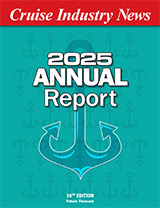Cruise ship prices have escalated dramatically since the late 60s when ships such as the Skyward were built for $13 million or roughly $17,287 per berth.
In the latest round of newbuilding orders, Kloster Cruise’s order of two 1,224-passenger vessels will cost $243 million each before allowing for subsidies, amounting to $198,529 per berth, while the 1,534-passenger Seaward was delivered in 1988 at a building cost of $120 million or $78,226 per berth.
Kloster’s order for a 212-passenger ship at the German Seebeck yard will cost $86.7 million or some $410,377 per berth. Seabourn Cruise Line’s nearly identical vessels were built at a cost of approximately $50 million each, or $235,849 per berth, delivered in 1988 and 1989.
The latest order is Club Med’s new sailing cruise ship which will be built at cost of $140 million or $311,000 per berth before subsidies.
While financing arrangements and subsidies often disguise the true cost of a vessel, it is clear that construction costs have increased dramatically. Prices have risen so much that Carnival Cruise Lines has not yet been able to contract the third of its “superships”, the Sensation, that was to have been built in Finland.
Starting from under $20,000 a berth in the late 60s, construction prices rose during the 70s to reach $100,000 and more in the early 80s. Today, the per berth price of a medium-sized cruise ship is around $200,000.
Investment Value
Carnival paid a per berth price for Holland America Line which clearly exceeded construction cost of those vessels, but when HAL previously acquired the two vessels of Home Lines, the price was below construction cost. When Kloster acquired Royal Cruise Line, the price seemed to reflect the building cost of its two vessels, but was much less than replacement cost. When Princess Cruises acquired Sitmar, the price was below construction cost and way below replacement cost of its tonnage.
The numbers do not always give a true picture, however. HAL’s Nieuw Amsterdam and Noordam, for instance, which were built in 1983 and 1984, at a cost of about $150 each, or some $123,558 per berth, should be strong moneymakers in today’s premium market based on the numbers. However, they can be expected to face increasingly tougher competition from Princess Cruises’ new ships, which although built at a cost of about $280 million each, amounting to $186,666 per berth, will also draw passengers because of their “newness.”
For investors, it may be a sound hypothesis that the value of existing cruise ships goes up as the construction prices of new ships go up and as market demand goes up. Also, a ship within a successful organization will at least maintain its value based on replacement cost. However, as the few examples show, there are no set rules to abide by, except those of the financial markets.
In order to consider a cruise ship a good investment or as a loan collateral, another key factor is the initial construction price. In the case of Carnival’s Fantasy, for example, the construction price was $225 million or $109,756 per berth, which seems like a bargain compared to its sistership, the Ecstasy, which is to delivered next year at a cost of $275 million, or $134,146 per berth.
Earlier this year, Chandris Celebrity Cruises took delivery of its new 1,500-passenger Horizon which was built for the premium market at a cost of $175 million, or $116,666 per berth.
Crystal Ball
Thus, in order for the book value to equal the ultimate resale value, it would also depend on other factors such as whether or not a ship would be subject to a forced sale and its market application. From the standpoint of size, it may be easier to command a higher price for a premium-market ship in the 40,000-ton, 1,000 to 1,500-passenger category, than a ship in the 70,000-ton, 2,000-passenger size, which has a more limited operations area and costs more to operate. But again, that may all depend on the soundness of the cruise market which again is a factor of the American economy.
While investors and lending institutions not only want to know how profitable the cruise lines are, but also how safe their money is, it is not any easier to answer that question about the cruise industry than any other industry.
Major financial institutions have recently downgraded the leisure industry on the basis of a soft economy and the looming recession. Several major firms now rate Carnival as a “market performer” in the short term while a “buy” recommendation is only given on a long term basis. Previously, several analysts had given the stock their highest recommendation. One major firm predicted a new 12-month range from $13.50 to $22.00 and reduced estimated earnings forecasts for 1990 and 1991.



